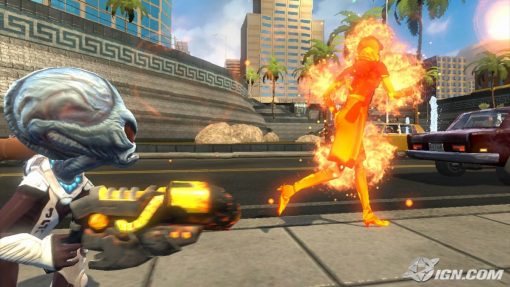Weird as it might sound, riffing on late 50s/early 60s Hollywood cheese was a popular trend in gaming for a little while. War of the Monsters was a free-roaming fighting game that riffed on the monster B-movie genre and Stubbs the Zombie had you playing as a shuffling undead salesman terrorising a retro-futuristic utopia. The best example of this odd, but amusing trope however was Destroy All Humans.
Developed in 2005 by the now-defunct Pandemic Studios, it was built around the same bones as their last free-roaming game, Mercenaries. This meant that everything exploded, the rag doll physics were ridiculously exaggerated and the map was vast. Instead of a grizzled mercenary sent in to kill your way though the North Korean high command however, you played as an archetypal ‘grey man’ alien sent to blast, vaporise and anal probe your way through an idyllic 50s American suburb. The concept actually originally came from Matt Harding, who shortly thereafter left Pandemic to travel the world and become Dancing Matt. Yep, that’s right, the concept for Destroy All Humans came from this guy:
The plot was fairly easy to grasp, you played as Cryptosporidium 137 (although you get the next clone in line every time you die), tasked with finding and recovering Crypto 136 from the US government, and extracting as many human brains as you could in the process. From their, unsurprisingly, a wide government conspiracy is uncovered relating to ‘Majestic’, a firm somewhere between the CIA and the MiB. The whole thing plays out like a fairly vicious spoof of 50s America, with a lot of the environment you explore looking like a 3D Norman Rockwell painting.
It’s far and away one of the funniest games I’ve ever played, with a lot of incidental Easter-eggs to find if you take the time to seek them out. A particularly amusing feature extends from your need to continuously read people’s minds in order to stay disguised as a human in populated areas. You’ll find people thinking about going home to take another Valium, how sexy Tupperware is, the appeal of barbecuing with Ike Eisenhower or just fantasing about Betty Page. It’s equally funny of course to just eschew the disguise altogether and run amok, as this was still a time in gaming when a vast array of nutty weapons was a foregone conclusion.
On foot (and strapped with a jetpack) Crypto could electrocute people, disintegrate them Mars Attacks style or anal probe them, which meant firing a blast through their rectum which would launch their brain into the air in a cloud of green goo. Failing that you could just telekinetically fling people, vehicles and objects around at your leisure. If you really had an appetite for destruction, however, you could get the flying saucer involved. Disintegration and general blasting were still on the menu once you took control of it, but you could also use a tractor-beam to hurl larger, heavier things than you could on foot and later in the game the ‘quantum destructor’ became available, a thermonuclear blast that wiped out everything within a certain distance.
Being able to actually destroy the environment at will within a sandbox might seem somewhat novel now, but at the time it was a huge deal and the idea of being able to trash something other than your standard grey, militarized wasteland was extremely appealing. As the missions progressed, more difficult enemies became the norm but unlike other, similar games they never created a barrier between you and all the fun, they just forced you to rethink your strategies.
The game enjoyed moderate success at the time and spawned one sequel, which put you on a more global playing field and had going after hippie stereotypes instead. It was more varied in terms of weapons and gameplay mechanics but no better overall. The sandbox genre has come a long way in terms of creative scope since GTA and Destroy All Humans was one of the first laudable examples of outside-the-box thinking. Games like Prototype and Infamous certainly owe a debt to it and it remains one of the crowning achievements of Pandemic’s short but impressive lifetime.
Some of the coverage you find on Cultured Vultures contains affiliate links, which provide us with small commissions based on purchases made from visiting our site. We cover gaming news, movie reviews, wrestling and much more.





